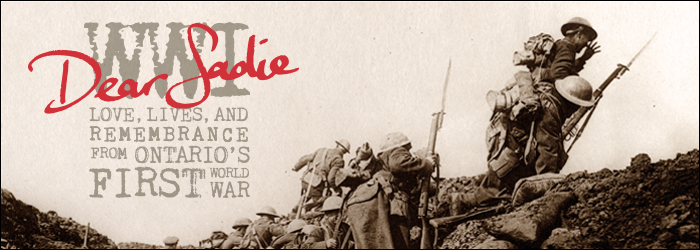
Harry Leaves Canada (and Sadie) Behind
|
"The English are proud of Canadians, as are all the other allies, and I’m proud too to wear Canada on my shoulders and the maple leaf on my cap and collar."
|
The first contingent of 33,000 Canadian soldiers landed in Britain on October 16, 1914. From there, they were soon transported to France, and were fighting at the front lines. Harry arrived at the front as part of the 4th Canadian Division, nearly a year later. After training in England, he was deployed to France in August 1916.
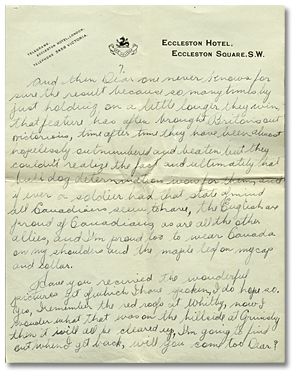
Click to see a larger image
Letter from Harry Mason to Sadie Arbuckle,
July 13, 1916
Sadie Arbuckle fonds
Reference Code: F 848
Archives of Ontario, I0070753
In Harry’s first letters from Europe, it is clear that his enthusiasm and that of his fellow soldiers was as strong as ever.
|
"[W]e don’t mind these little hardships and inconveniences so long as we further our training and promote the cause of Canada – you would be surprised Dear to see how cheerfully the men – every one accepts the varied conditions and how absolutely anxious they are to become thoroughly fit for the supreme test which they all hope some day to experience...
"
|
Canada’s soldiers were not alone in their zeal. Back home in Canada, posters were being put up across the country, and these showed the same optimism and excitement. Canadian men were called to enlist by smiling faces in clean, comfortable uniforms. There were few hints at the danger involved, and victory seemed assured.
![Here's your chance - It's men we want [Canada], [between 1914 and 1918]](pics/16180_your_chance_270.jpg)
Click to see a larger image
Here's your chance - It's men we want
[Canada], [between 1914 and 1918]
Black and white print
Archives of Ontario poster collection
Reference Code: C 233-2-4-0-200
Archives of Ontario, I0016180
![Canadiens français, enrolez-vous au 150ième Carabiniers Mont Royal, sous le commandement du Lieutenant Colonel H. Barré [French Canadians, enlist with the 150th Mont Royal Carabiniers, under the command of Lieutenant Colonel H. Barré], [between 1914 and 1918]](pics/16177_mont_royal_770.jpg)
Click to see a larger image
Canadiens français, enrolez-vous au 150ième Carabiniers Mont Royal, sous le commandement du Lieutenant Colonel H. Barré [French Canadians, enlist with the 150th Mont Royal Carabiniers, under the command of Lieutenant Colonel H. Barré],
[between 1914 and 1918]
Colour print
Archives of Ontario poster collection
Reference Code: C 233-2-4-0-197
Archives of Ontario, I0016177
![Come and Do Your Bit. Join Now, [between 1914 and 1918]](pics/22019-come-and-do-your-bit-700.jpg)
Click to see a larger image
Come and Do Your Bit. Join Now, [between 1914 and 1918]
Colour print
Archives of Ontario poster collection
Reference Code: C 233-2-7-0-308
Archives of Ontario, I0022019
But this cheerfulness did not mean that the soldiers did not know the dangers they would be facing. Harry shared these thoughts with Sadie, too, but always acknowledging that he should take care not to tell her too many upsetting details.
After the 80th Battalion sailed to England, it was absorbed into other units and Harry found himself part of the 67th Battalion, known as the Western Scots. He was deployed to France on August 9, 1916, and was in the trenches of Belgium by August 19.
|
"[S]ome of us must be killed and wounded because this is war we all hope for the less severe but we know that some must pay the great sacrifice and I believe that everyone if necessary is willing – but Dear this isn’t cheerful and everyone must realize this part of modern war."
|
His letters provide detailed accounts of the life of a CEF soldier in France waiting to be deployed to the trenches.
|
"
It seems Sweetheart almost impossible that I am so near the activity of the greatest and most awful war the world has ever known, everyone is so cheerful and bright but at the same time ever prepared for any emergency.
"
|
|
"
[T]he lumber in these board floors [in billets] is the hardest wood in the world but we are tired and sleep like logs but our poor bones are very tired and sore in the morning, but we are quite cheerful nevertheless, in fact Dear it is hard for you to imagine such abandon cheerfulness when so soon for some of us it will be quite the reverse, it is good Sweetheart to see such a spirit, because that is what wins our battles and makes our work much easier and more pleasant.
"
|
The 67th was a pioneer battalion, which meant it was primarily responsible for engineering tasks such as construction and repair work. For Harry this meant digging and fortifying trenches, building sandbag blockades, and providing supply routes for other units, all while under enemy fire.
|
"
[O]ur tour here has been a very long one, much longer than usual, we as pioneers don’t do so badly our work is very hard and dangerous but at least we return after each tour to billets where we can get dry and warm before going out again... The infantry admire and pity the pioneers in their work because we must defy Fritz and go on with the work no matter how intense the fire, they wouldn’t transfer into the pioneers if they could help it...
"
|
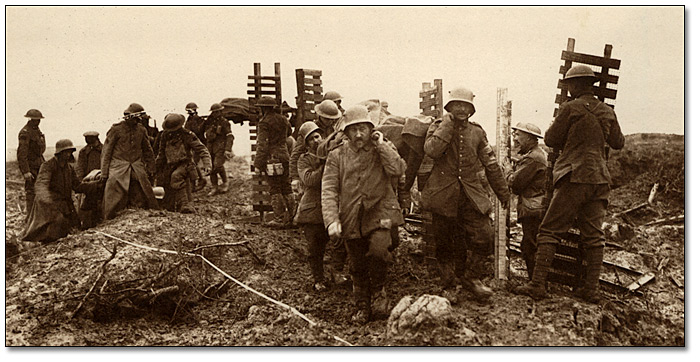
Click to see a larger image
Canadian Pioneers carrying trench material to Passchendaele
quitting work while German prisoners carrying wounded pass by, 1917
Unknown photographer
Black and white print
Canadian Expeditionary Force albums
Reference Code: C 224-0-0-10-19
Archives of Ontario, I0004829
Harry’s first letters from the front lines sounded less enthusiastic about the experience of war. He was also careful not to reveal details that could prove dangerous in enemy hands.
|
"
I have been under schrapnel [sic], machine gun and rifle fire already and though at first it started little shivers chasing each other down my spine, I am now used to it and I’m glad because we are bombarded some time during each day and night and yesterday a sniper took two shots at me which luckily didn’t register, but I didn’t stay around that place very long, it is quite thrilling to hear the whistle as they sing past and hear them slap into the mud...
"
|
|
"
[T]he best part of it is Dearest I really like it, it’s dangerous almost any minute a sniper may take a shot or a shell drop but I really do like it so far... I wish I could safely name the place but I must not it is very very well known, and famous for previous battles fought by Canadians earlier in the war and the place is quite covered in the rear with little wooden crosses marking the graves of our heroes.
"
|

|
Click below to hear a portion of the letter above |
![A Canadian soldier badly wounded in his shoulder and leg drinking hot coffee at a soup kitchen 100 yards from the German lines at Hill 70, [ca. 1918]](pics/4820-soldiers-coffee-300.jpg)
Click to see a larger image
A Canadian soldier badly wounded in his shoulder
and leg drinking hot coffee at a soup kitchen
100 yards from the German lines at
Hill 70, [ca. 1918]
Unknown photographer
Canadian Expeditionary Force albums
Black and white print
Reference CodeC 224-0-0-10-10
Archives of Ontario, I0004820
![A Canadian sentry at his post composed of ammunition boxes and bricks from old houses,[ca. 1918]](pics/4821-soldier-reading-300.jpg)
Click to see a larger image
A Canadian sentry at his post composed of ammunition
boxes and bricks from old houses,[ca. 1918]
Unknown photographer
Canadian Expeditionary Force albums
Black and white print
Reference Code: C 224-0-0-10-11
Archives of Ontario, I0004821
|
"
[T]he trees at least quite a few have been literally blown up by the roots or every bit of their limbs have gone by shell fire leaving only a scarred trunk which presents in a ghostly way the once beautiful Belgium and the villages and towns are a heap of debris over run with rats – the fields once very fertile are now a barren shell pitted ruin through which run trenches...
"
|
Click to see a larger image
The castle at Ham [Belgium] in ruins after
having been destroyed by the Germans on
their retreat, [ca. 1918]
Black and white print
Photograph albums of the First World War
Reference Code: C 224-8, Item C 224-0-0-9-42
Archives of Ontario, I0004801
Even in these early days, while dealing with the overwhelming action taking place all around him, Harry was captivated by the soldiers who fought from the air.
|
"
It is very interesting to watch our aeroplanes sail over Fritz... first you see the flash then the smoke and afterward the report just now they fired 135 shells at one aeroplane and they are still firing and he is still sailing blissfully on so you can see how daring our airmen are and how Fritz wastes his ammunition.
"
|
Click to see a larger image (395K)
The War In the Air, 1917
After C. R. W. Nevinson
Reference Code: C 334-2-0-0-9
Archives of Ontario, I0013656
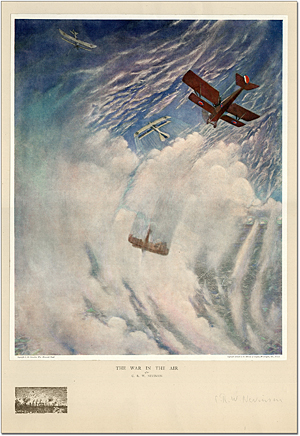
As the war progressed, Harry’s battalion saw heavy losses and as an officer, Harry felt a strong sense of responsibility. He respected his troops and often spoke highly of them to Sadie. Their deaths weighed heavily on him and his sense of enthusiasm seemed to be waning.
![“The rawest raw recruits,” from left to right: Lieutenant Coward, Lieutenant Bertrand, Captain Lockett, Lieutenant Harry Mason (seated), Captain Nichols, and Lieutenant Winslow, [ca. 1914-1917]](pics/50211-raw-soldiers-700.jpg)
Click to see a larger image
“The rawest raw recruits,” from left to right:
Lieutenant Coward, Lieutenant Bertrand, Captain Lockett, Lieutenant Harry Mason (seated),
Captain Nichols, and Lieutenant Winslow, [ca. 1914-1917]
Black and white print
Sadie Arbuckle fonds
Reference Code: F 848
Archives of Ontario, I0050211
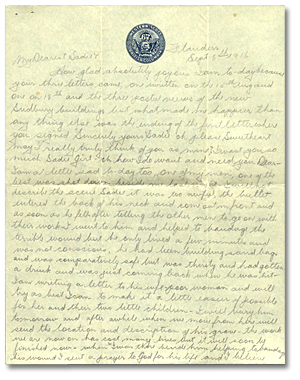
Click to see a larger image
Letter from Harry Mason to Sadie Arbuckle,
September 8, 1916
Sadie Arbuckle fonds
Reference Code: F 848
Archives of Ontario, I0071018
|
"
[O]ne of my men, one of the best was shot down beside me last night – I will not describe the scene Sadie it was too awful, the bullet entered the back of his neck and come out in front and as soon as he fell – after telling the other men to go on with their work – I went to him and helped to bandage the terrible wound but he only lived a few minutes and was not conscious, he had been building sandbags and was comparatively safe but was thirsty and had gotten a drink and was just coming back when he was hit – I am writing a letter to his wife – poor woman and will try as best I can to make it a little easier if possible for her and their two little children – I will bury him to-morrow and after a while when we move from here will send the location and description of his grave...
"
|

|
Click below to hear a portion of the letter above |
The letter he wrote to that fallen soldier’s wife provided her with some much-needed empathy and she responded:
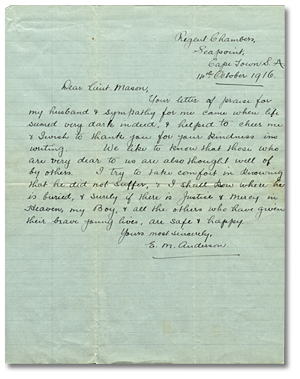
Click to see a larger image
Letter from E.M. Anderson to Harry Mason, October 14, 1916
Sadie Arbuckle fonds
Reference Code: F 848
Archives of Ontario, I0071144
|
"Dear Lieut. Mason, |

|
Click below to hear a portion of the letter above |
